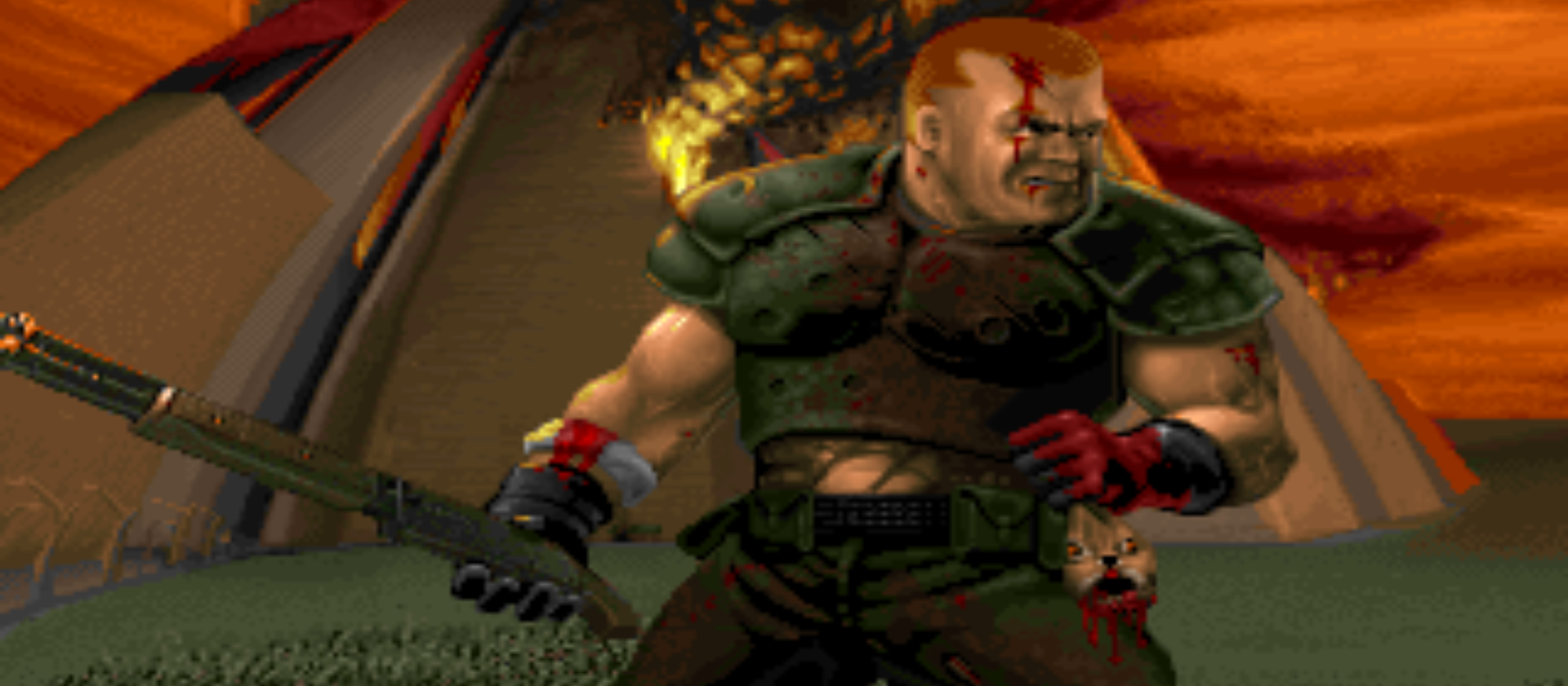
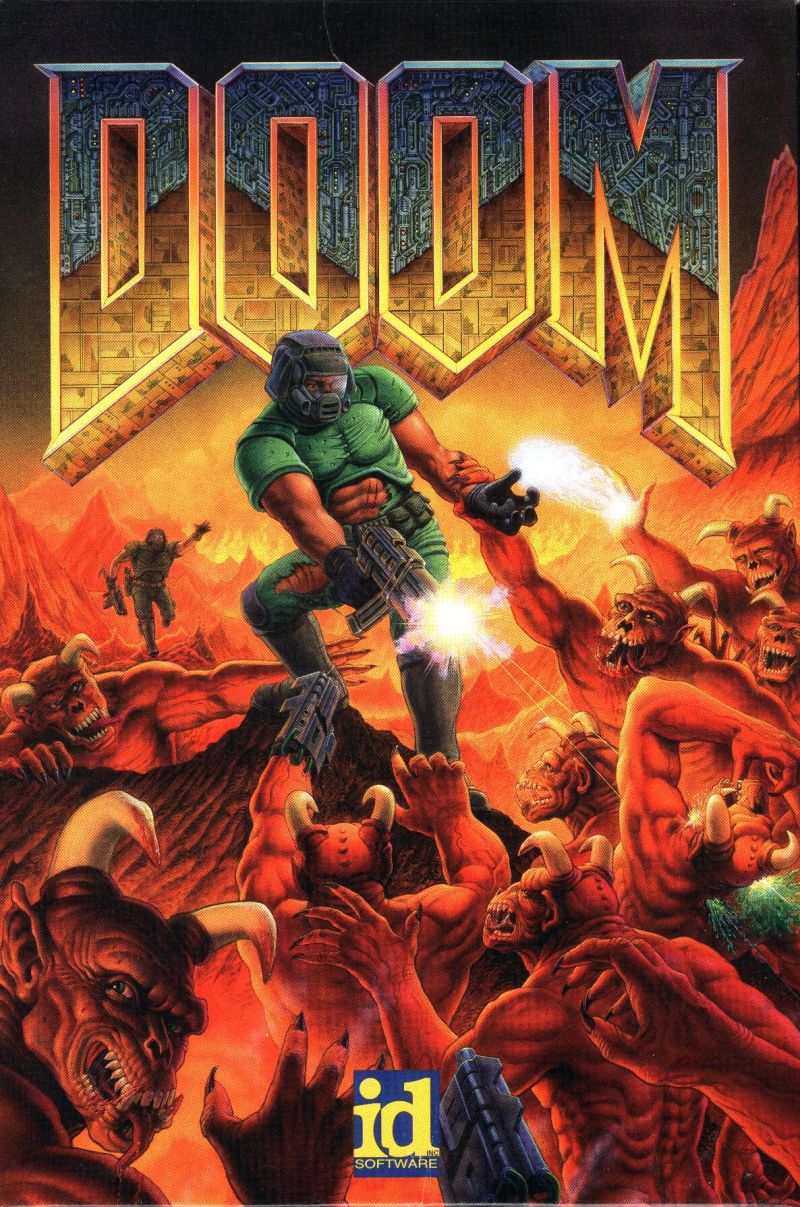
“Looks like you’re stuck on the shores of Hell. The only way out is through.”
I had not yet graced the earth with my presence when Doom was first released as shareware. I was barely a year old when the expanded edition—which added a fourth nine-mission episode—hit store shelves. By the time I was old enough to want to shoot other people in the face (virtually, of course), games like Doom were called “first person shooters”—a fitting name, but not the label that the genre was always tagged with. In fact, until the late 1990s, first person shooters were simply known as “Doom clones.” That is to say that Doom was such a purple cow that it didn’t just inspire ripoffs or make wads of cash, but it influenced a new generation of game developers and still serves as a touchstone today. It’s a triumph of design innovation, addictive gameplay, aesthetics, and cultural integration—a watershed moment in gaming history that set the parameters of a new genre and permanently changed the landscape of the medium.
The year before Doom, id Software had released Wolfenstein 3D, which is considered to be the “grandfather of 3D shooters.” Considering only about a year and a half separates their release dates, what the same team of young game designers accomplished with Doom is remarkable. Taking the basics of fast-paced action from Wolfenstein, id Software co-founder and lead programmer John Carmack made a number of innovations in different areas that elevated Doom to an entirely new level, one that the gaming world had never seen before. Capitalizing on the improvements in the speed of microprocessors, Carmack built a new engine that added texture mapping and dynamic lighting. This gave the environments more character and added substantially to the game’s sinister atmosphere.1 Instead of the grid-based architecture that had been used before, walls could be placed at any angle, and floors and ceilings could be different heights. The levels became dynamic, characterized by elevators, stairs, and windows instead of the repetitive square hallways and flat landscapes of yesteryear. This gave the level designers a much larger creative role in the game; instead of simply adding more square footage to expand a level, the designers could add exploration and puzzle elements into a smaller map. From a mathematical perspective, this allowed the developers to pack more into the same amount of virtual space—essentially increasing the density of awesomeness/area.
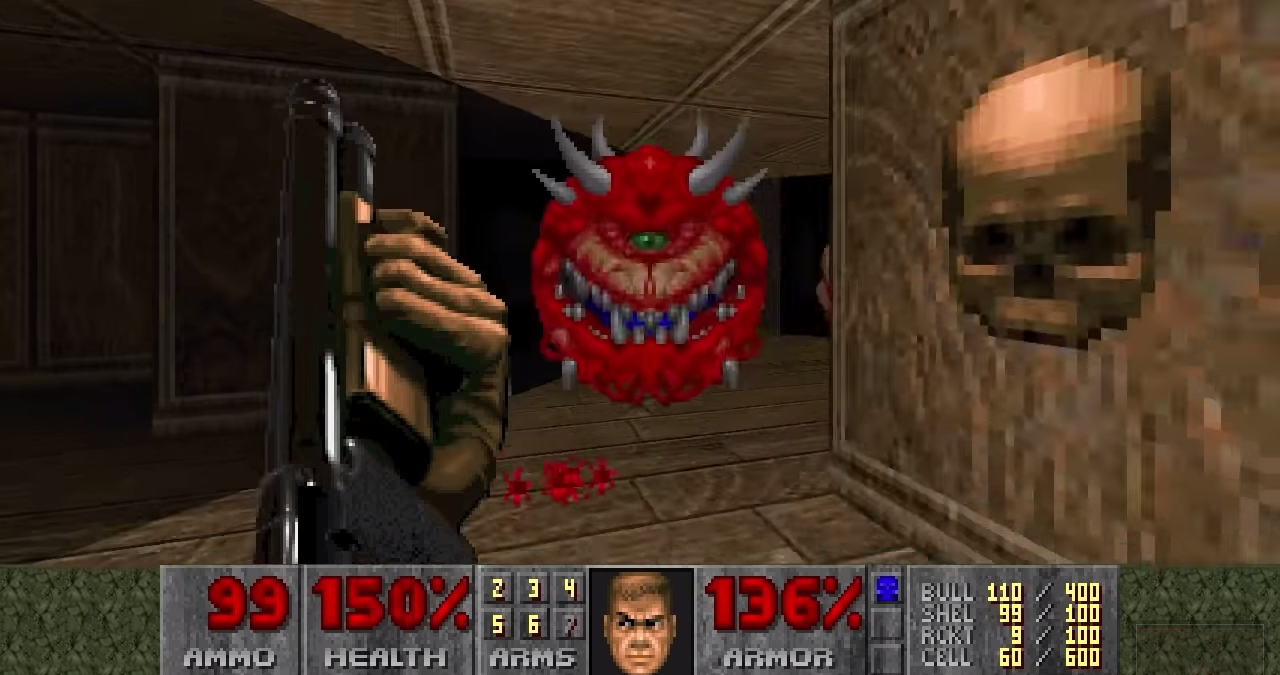
In general, the originator of something new is often not the same person who capitalizes on it.2 In the case of id Software, however, the young gamemakers confidently maximized the potential of their new game engine with swagger. The genius of John Carmack was elevated by the chutzpah and gamesmanship of his partner John Romero, a consummate video game junkie who had an uncanny ability to perfectly envision how to maximize the potential of Carmack’s innovations. (Their story is told in fascinating detail in David Kushner’s Masters of Doom.) One of the things I love most about Doom is its lack of pretension. Well, it is pretentious, but a good version of it—a version largely informed by correct thinking. “Story in a game is like a story in a porn movie. It’s expected to be there, but it’s not that important,” says Carmack. That’s the kind of self-assuredness the team of twenty-somethings had when they convinced themselves that it didn’t really matter why the player-controlled space marine was battling demons unleashed from Hell solo on the moons of Mars; that was story enough, and the gameplay would take care of the rest. It’s not for me to say if it could have been better with a deeper story; but I am confident in asserting that it is undeniably great with its focus chiefly on the gameplay.
The objective is simple: you start the game with a weapon in hand—now fight your way to the exit. Without an elaborate setup or contrived storyline to interfere, you are dumped right into the action. Scattered throughout the levels are various health and armor pickups, ammunition, better weapons (seven total, including the BFG—I’ll let you figure out the acronym if you don’t know it already), radiation suits, berserk packs, invisibility and invulnerability orbs, and color-coded keys to unlock doors throughout a given level. Unlike many modern games, where health “recharges” if you stay in one spot without taking damage for long enough, hiding in Doom does nothing except delay the confrontation with the legions of hellspawn that you must face.
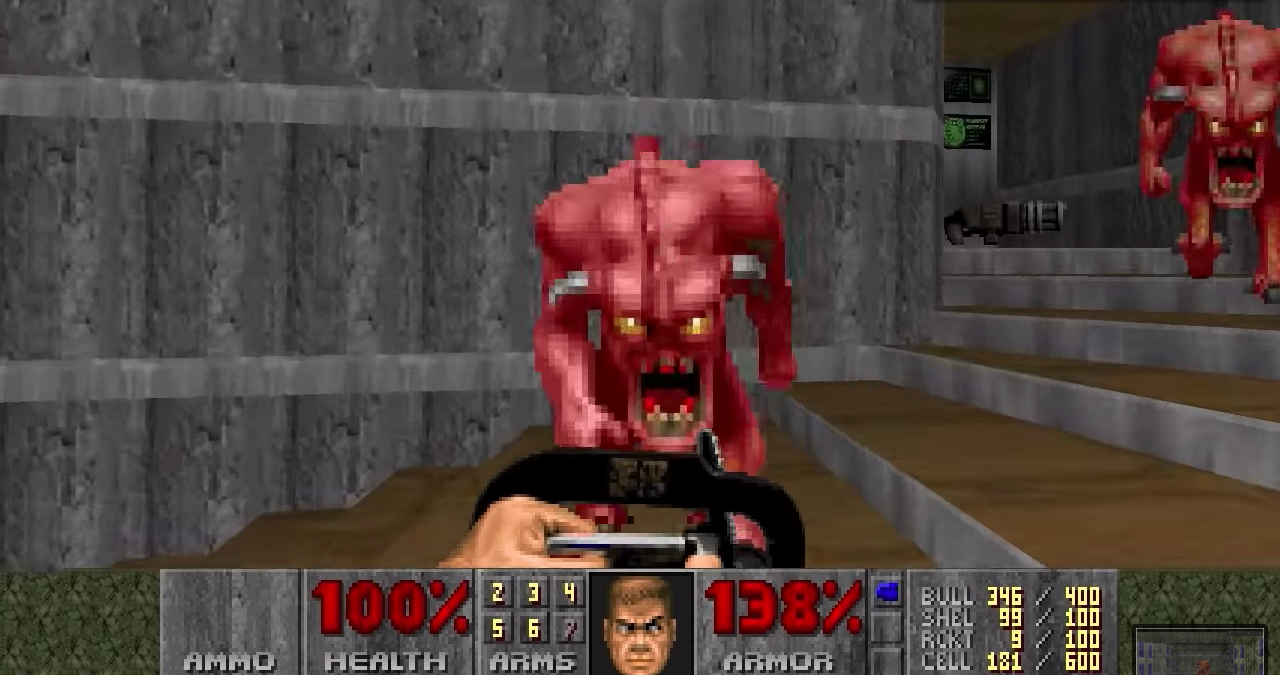
The enemy ranks in Doom are pleasantly varied. We’ve got zombiemen, imps, shotgunners, demons, specters, lost souls, cacodemons, barons of hell, cyberdemons, spider masterminds—and each does something unique that differentiates them from the others. Enemies are fairly predictable once you learn how each type acts, but the combinations can put you into tough spots in a hurry. Part of the old-school charm of Doom is that the enemies appear as 2D sprites within the game’s 3D world. Each enemy has only a handful of poses, which they switch between to indicate their movement patterns and attack status.
The weapons also vary in their uses. While the shotgun is the go-to because its ammo is plentiful and its range incredible, the rocket launcher, chaingun and plasma gun are all very useful. I found the chainsaw to be somewhat difficult to manage and often took damage when trying to use it. I think that’s less a problem with the game and more of a lack of finesse on my part.
But Doom, despite its reputation of gore, is not really about shooting—it’s about movement. There is little reason to hide from your enemies because you can run rings around them. You can’t aim for an enemy’s weak spot because you can’t even look up or down. Instead, you maneuver. You can trick your enemies into firing on one another and start an in-fight, you can try to position yourself into an easier series of one-on-one showdowns, or you can try to leave tougher enemies in the dust and make your way to the exit with less than 100% of the kills (the game tracks that for you). Maybe that sounds too silly, but let me tell you, it’s miles better than the endless series of cover-based firefights and checkpoints that make up many modern shooting games.
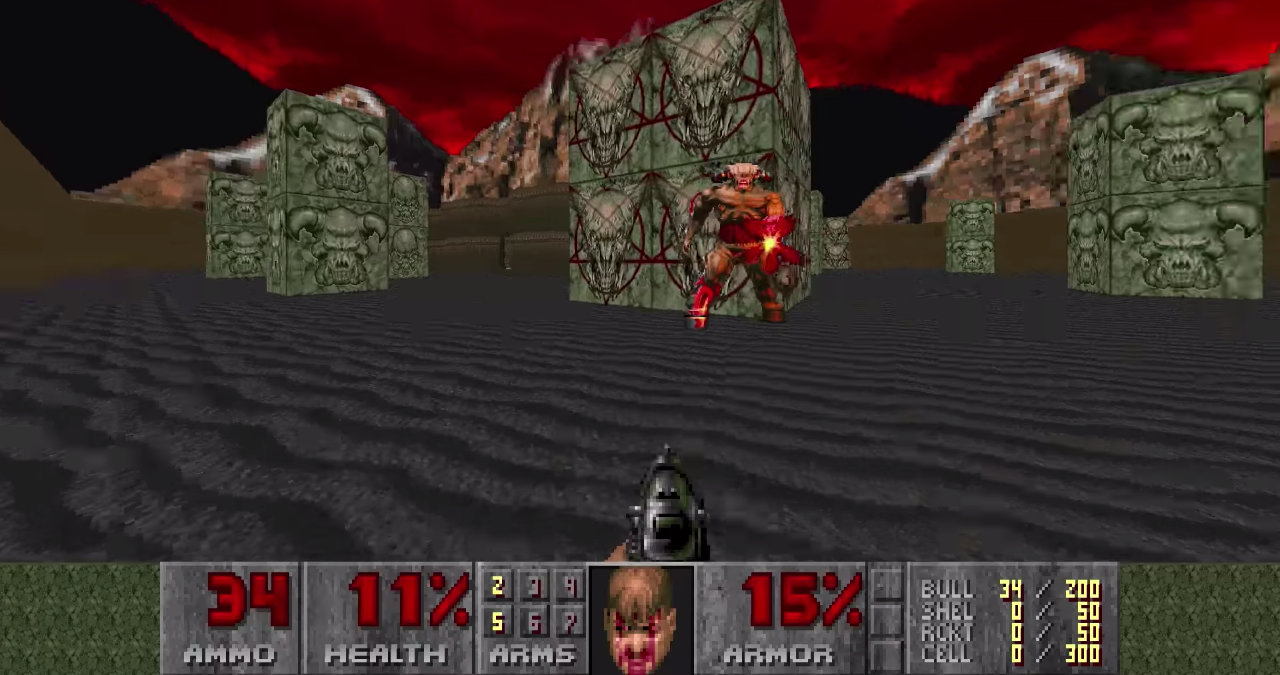
To ensure the player is capable of combating these forces of hell, the developers gave them insane movement speed. This makes combat (which is the core of the entire game) incredibly engaging. You’ll find yourself somehow “in tune” with the flow of enemies, dodging between slow moving fireballs, twitching your gunbarrel into the direction of shotgunners before they can fire at you, switching quickly to your rocket launcher to take down a cacodemon, sprinting to a little nook for a momentary respite, and so on. On the second highest difficulty (I don’t know if I’ll ever work up the courage to attempt the highest, in which enemies respawn shortly after you kill them), I was thoroughly challenged yet never found myself backed into an impossible corner where I didn’t think success was possible. The only time I grew truly frustrated was at a certain section where the player must be “nimble” with their footwork, which was very tough considering how fast the player moves about the map and that you can’t look up or down.
Because of the elementary puzzle elements used in the game, it is very likely that one could get a better time if they played a level repetitiously to familiarize themselves with the level design and commit some of the important bits to memory. After the game’s release, determining a level’s fastest route quickly became a challenge for many players. To encourage this behavior, John Romero beat each level of the game as fast as he could, then added thirty seconds and called that the “par time.” At the end of each completed mission, the player’s time is displayed next to the par time. (I did not make a single par on my first playthrough).
The creators of Doom were deeply influenced by both film and music. The game’s premise and ghastly enemies are very similar to those in Alien, while its silent protagonist is reminiscent of tight-lipped action heroes of the ‘80s and early ‘90s. Stallone and Schwarzenegger had big muscles and carried brutal firearms, but the inspiration for Doomguy’s chainsaw and the blood-soaked gore has to be Army of Darkness. The inspirations from Hollywood largely helped to set the tone and atmosphere of the game (i.e. they didn’t really take “cinematic” cues from cinema, which in this case is good), and they are complemented nicely by the game’s varied soundtrack. The designers were heavily into the metal scene and asked Bobby Prince to create MIDI ripoffs of some of their favorite music—Metallica, Alice in Chains, Slayer. He obliged and provided many levels with fast paced music that fits the frenetic gameplay. However, he also composed several ambient tracks that impressed John Romero, who put them into the finished game. ‘Sign of Evil’—one of my favorite tracks from the game—is a slow-burning, stoned-out jam that plays over the final mission of the game’s first episode in which the player faces off against two Barons of Hell. On paper this combo of demons, rocket launchers, and gore mixed with ambient music shouldn’t work, but it absolutely does.
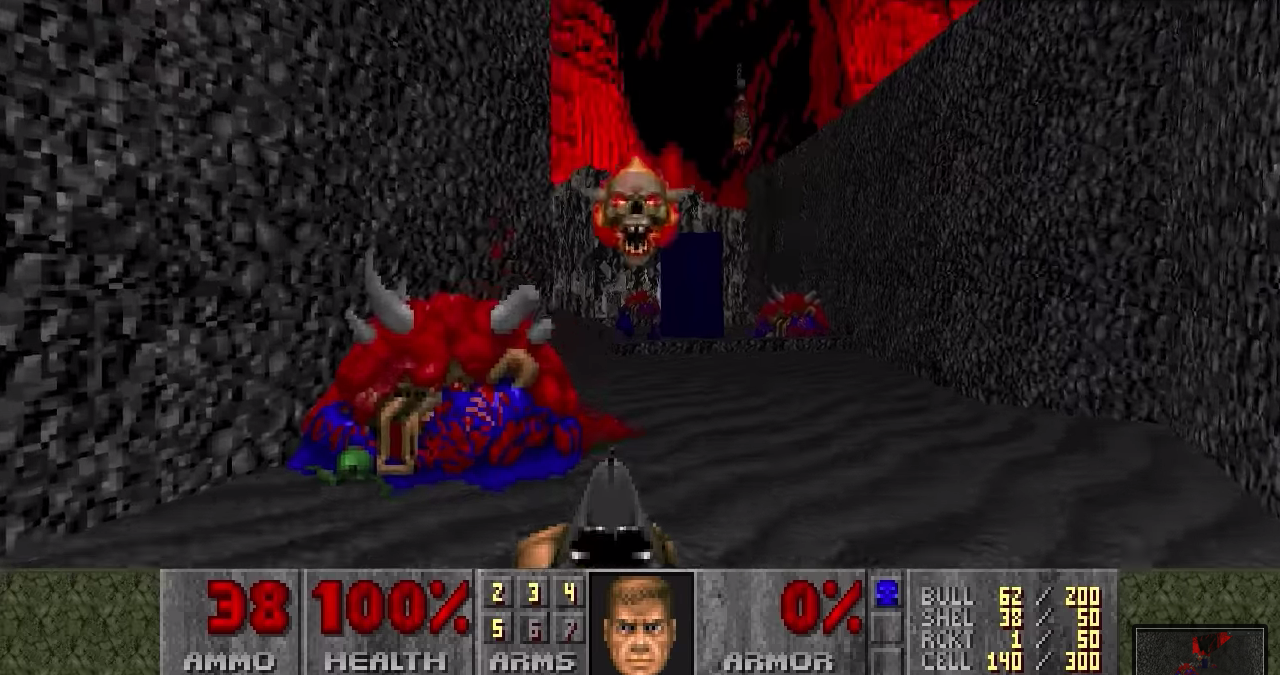
Bobby Prince also provided the game’s sound effects, and boy did he nail the guttural animal noises that serve as the howls and grunts of demons. Consider that Carmack’s dynamic lighting system allowed for him and Romero to design levels in which the lights can strobe or even shut off entirely, then layer on some bloodcurdling screeches from enemies that were not present when the lights went out. Since Prince owned the entirety of the sound, he ensured the demonic cacophony and the music tracks remained distinct in the sound mix.
Late in the development cycle, Carmack remembered that he had told Romero he may be able to implement a mode that would allow players to take part in head-to-head battles. Throwing it together almost as an afterthought, the team launched the phenomenon called ‘deathmatch’ that has since become a mainstay of the FPS genre and multiplayer gaming, growing in popularity as online gaming and high-speed internet have become ubiquitous. I haven’t had much experience with the multiplayer; it would have been awesome to experience it in its heyday, but it’s easy enough to understand its impact. It was so addictive that Romero spent more time playing the game and doing publicity for it than he did working at id, which led to his firing shortly after the release of Quake.
The bottom line is that Doom is a great game today. Not as a novelty item or because of nostalgia—by modern standards this game is very good. It is certainly mysterious how it seemed to have leapt ahead of the regular iterative design process—by which designers make incremental improvements on past games, ransack the competition’s newest product for ideas, and come up with something familiar but a little bit better—and came out as a groundbreaking game decades ahead of its time. It blew the doors off the competition in 1993, of course, but somehow it remains perched atop a steep mountain that is impossible to approach. It has nearly everything going for it: fast-paced, engaging combat; an abundance of style; an integration of pop culture by way of action sci-fi cinema, heavy metal and ambient music. By now it also has the nostalgic glow of retro charm with its 2D sprites and repetitive sound effects, but considering how well the back-to-basics 2016 reboot was received, I think it’s safe to say that the allure of Doom lies in its simple yet brilliant gameplay mechanics. Maybe Carmack, Romero and co. were onto something.
1. The game engine which allowed for many of these innovations was actually licensed to Raven Software for their game ShadowCaster which came out prior to Doom. It was successful at the time but lacks much of the magic that makes Doom beloved even today.
2. Consider that the first film with synchronous sound (The Jazz Singer) came out in 1927, while Coppola’s The Conversation, in which the sound design is almost a character itself, was released in 1974. Or consider the early use of Technicolor prior to its use in The Wizard of Oz (probably the oldest Technicolor film that the layperson has seen—or even the oldest color film that they’ve seen, for that matter). This list is endless: portable cameras, the electric guitar, the early beats of hip hop, stream-of-consciousness writing, the use of green screen, etc.
Sources:
Kushner, David. Masters of Doom: How Two Guys Created an Empire and Transformed Pop Culture. Random House. 2003.
Brown, Stuart. “RetroAhoy: Doom”. Youtube, Ahoy. 24 January 2016.